Corporate Governance Application in Management Accounting Analysis
VerifiedAdded on 2023/06/06
|11
|2774
|196
Case Study
AI Summary
This case study examines the critical role of corporate governance in preventing financial reporting fraud within a medium-sized Australian company. It highlights how weak corporate governance can enable fraudulent activities, such as inflating profit figures to mislead shareholders, as demonstrated by the CEO's and a non-executive director's actions. The analysis references Australian Accounting Standards (AASB 101) and relevant corporate governance theories, including Agency Theory, Stewardship Theory, and Stakeholder Theory, to underscore the importance of ethical financial reporting and accountability. The case emphasizes that a robust corporate governance system is essential for ensuring transparency, fostering trust among stakeholders, and deterring management-level employees from engaging in unethical practices that could lead to significant financial losses for the company. The document is contributed by a student and available on Desklib with other solved assignments.
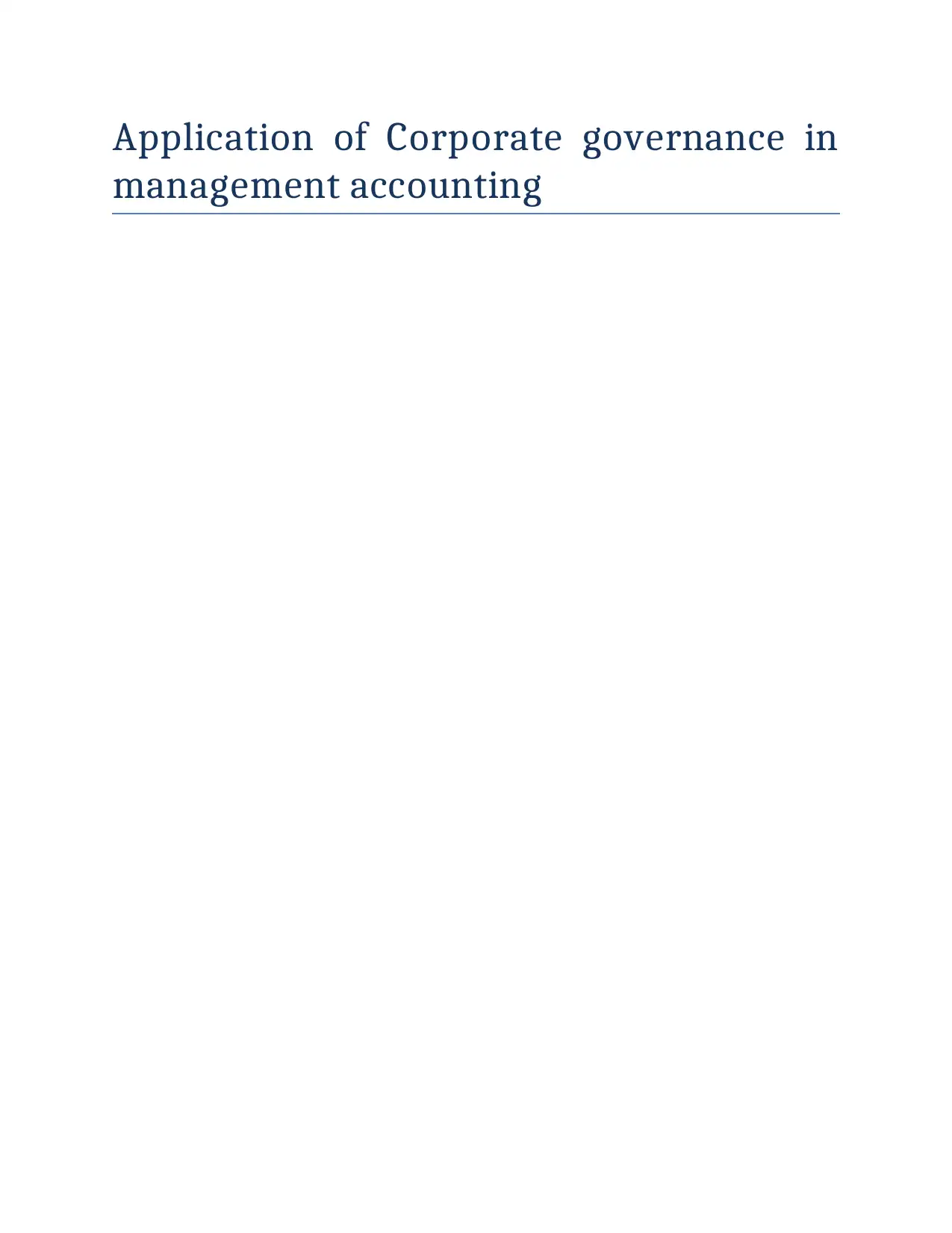
Application of Corporate governance in
management accounting
management accounting
Paraphrase This Document
Need a fresh take? Get an instant paraphrase of this document with our AI Paraphraser
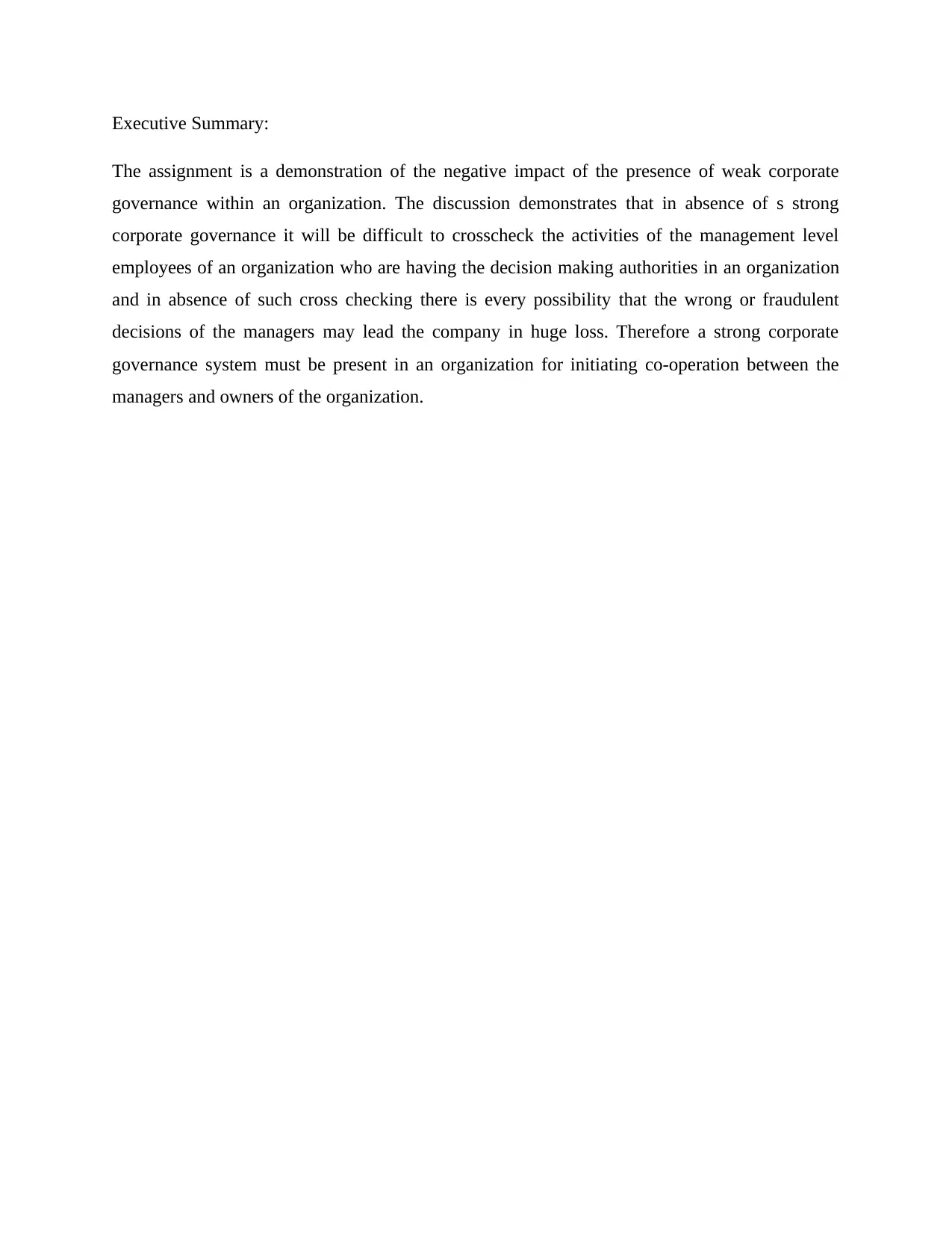
Executive Summary:
The assignment is a demonstration of the negative impact of the presence of weak corporate
governance within an organization. The discussion demonstrates that in absence of s strong
corporate governance it will be difficult to crosscheck the activities of the management level
employees of an organization who are having the decision making authorities in an organization
and in absence of such cross checking there is every possibility that the wrong or fraudulent
decisions of the managers may lead the company in huge loss. Therefore a strong corporate
governance system must be present in an organization for initiating co-operation between the
managers and owners of the organization.
The assignment is a demonstration of the negative impact of the presence of weak corporate
governance within an organization. The discussion demonstrates that in absence of s strong
corporate governance it will be difficult to crosscheck the activities of the management level
employees of an organization who are having the decision making authorities in an organization
and in absence of such cross checking there is every possibility that the wrong or fraudulent
decisions of the managers may lead the company in huge loss. Therefore a strong corporate
governance system must be present in an organization for initiating co-operation between the
managers and owners of the organization.
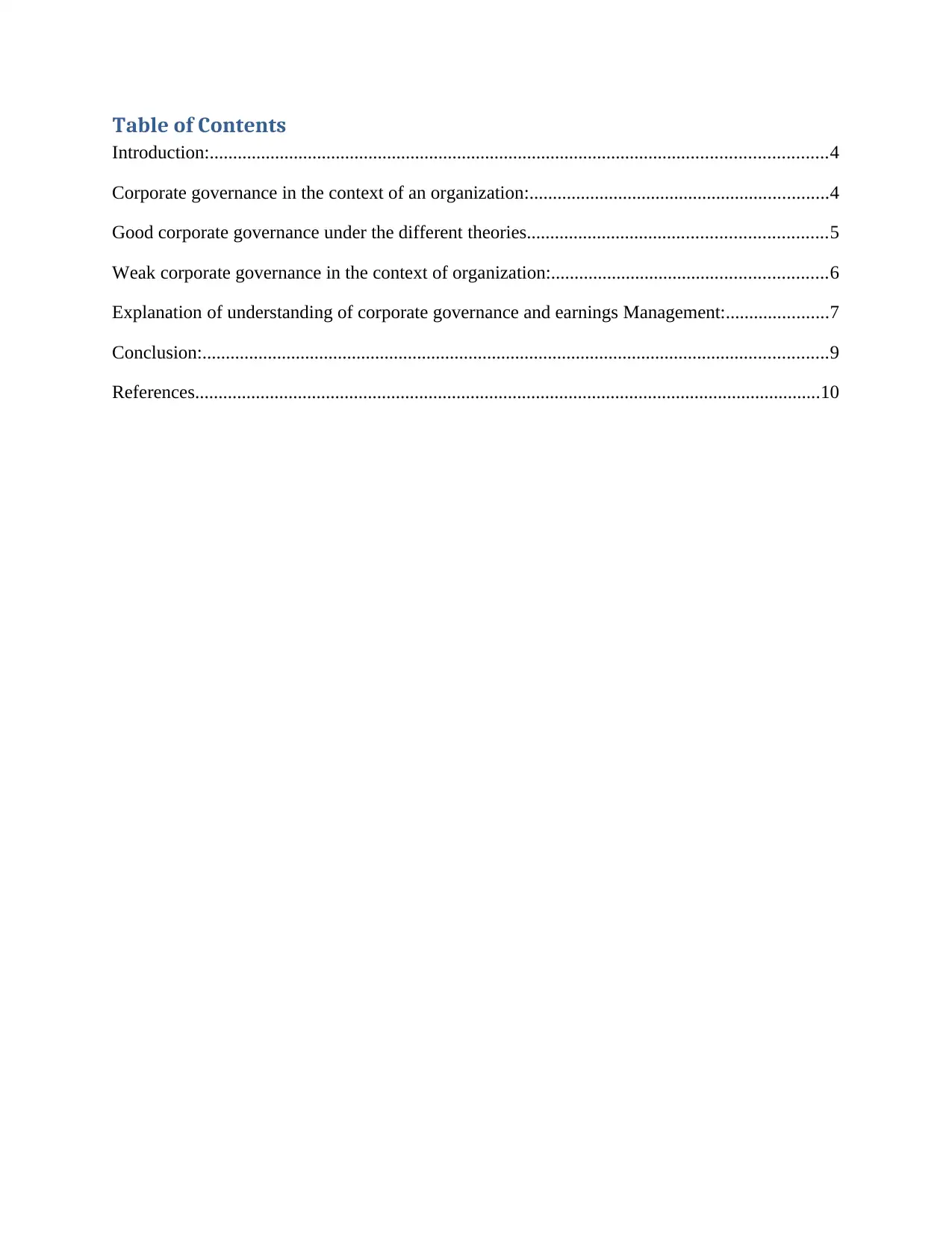
Table of Contents
Introduction:....................................................................................................................................4
Corporate governance in the context of an organization:................................................................4
Good corporate governance under the different theories................................................................5
Weak corporate governance in the context of organization:...........................................................6
Explanation of understanding of corporate governance and earnings Management:......................7
Conclusion:......................................................................................................................................9
References......................................................................................................................................10
Introduction:....................................................................................................................................4
Corporate governance in the context of an organization:................................................................4
Good corporate governance under the different theories................................................................5
Weak corporate governance in the context of organization:...........................................................6
Explanation of understanding of corporate governance and earnings Management:......................7
Conclusion:......................................................................................................................................9
References......................................................................................................................................10
⊘ This is a preview!⊘
Do you want full access?
Subscribe today to unlock all pages.

Trusted by 1+ million students worldwide
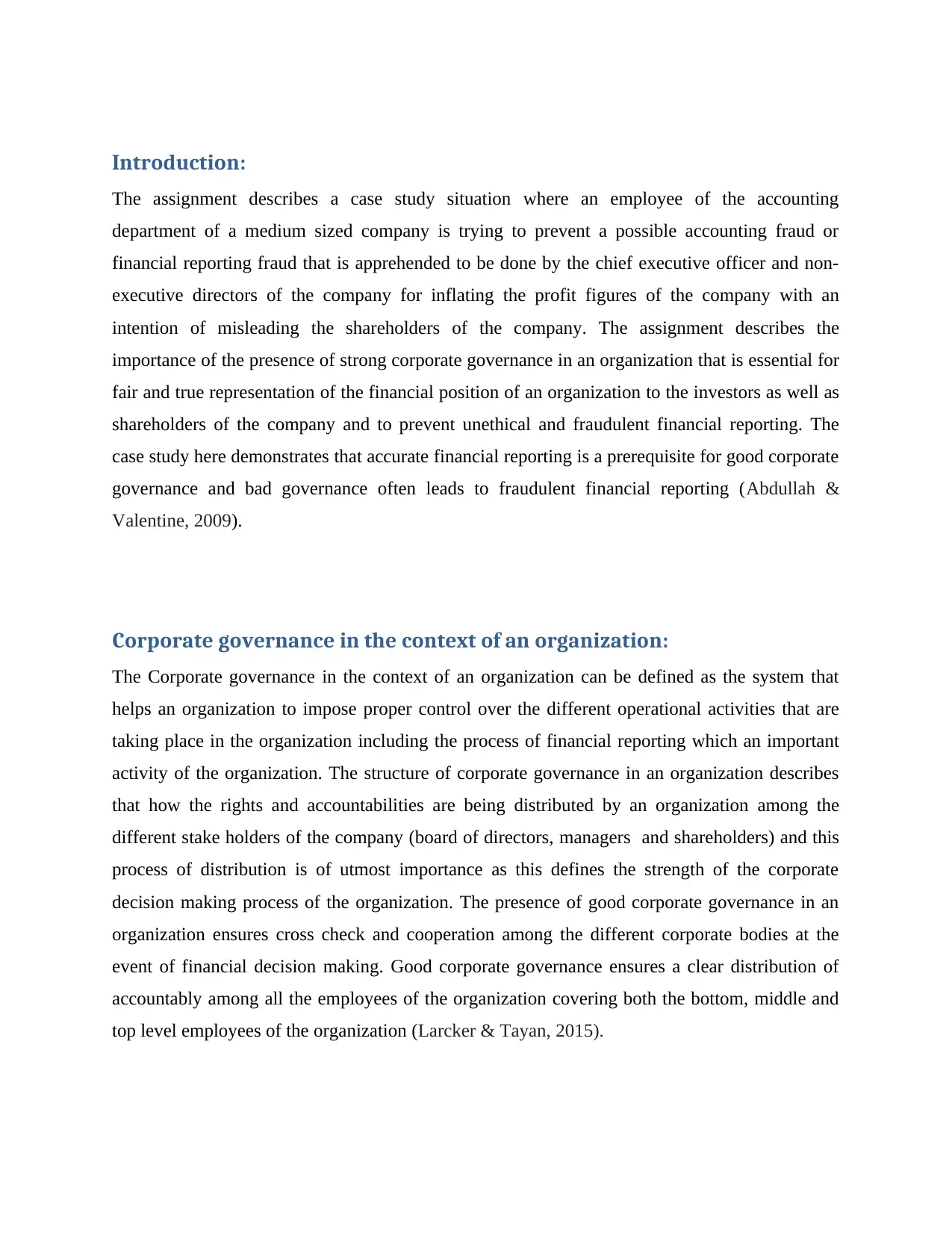
Introduction:
The assignment describes a case study situation where an employee of the accounting
department of a medium sized company is trying to prevent a possible accounting fraud or
financial reporting fraud that is apprehended to be done by the chief executive officer and non-
executive directors of the company for inflating the profit figures of the company with an
intention of misleading the shareholders of the company. The assignment describes the
importance of the presence of strong corporate governance in an organization that is essential for
fair and true representation of the financial position of an organization to the investors as well as
shareholders of the company and to prevent unethical and fraudulent financial reporting. The
case study here demonstrates that accurate financial reporting is a prerequisite for good corporate
governance and bad governance often leads to fraudulent financial reporting (Abdullah &
Valentine, 2009).
Corporate governance in the context of an organization:
The Corporate governance in the context of an organization can be defined as the system that
helps an organization to impose proper control over the different operational activities that are
taking place in the organization including the process of financial reporting which an important
activity of the organization. The structure of corporate governance in an organization describes
that how the rights and accountabilities are being distributed by an organization among the
different stake holders of the company (board of directors, managers and shareholders) and this
process of distribution is of utmost importance as this defines the strength of the corporate
decision making process of the organization. The presence of good corporate governance in an
organization ensures cross check and cooperation among the different corporate bodies at the
event of financial decision making. Good corporate governance ensures a clear distribution of
accountably among all the employees of the organization covering both the bottom, middle and
top level employees of the organization (Larcker & Tayan, 2015).
The assignment describes a case study situation where an employee of the accounting
department of a medium sized company is trying to prevent a possible accounting fraud or
financial reporting fraud that is apprehended to be done by the chief executive officer and non-
executive directors of the company for inflating the profit figures of the company with an
intention of misleading the shareholders of the company. The assignment describes the
importance of the presence of strong corporate governance in an organization that is essential for
fair and true representation of the financial position of an organization to the investors as well as
shareholders of the company and to prevent unethical and fraudulent financial reporting. The
case study here demonstrates that accurate financial reporting is a prerequisite for good corporate
governance and bad governance often leads to fraudulent financial reporting (Abdullah &
Valentine, 2009).
Corporate governance in the context of an organization:
The Corporate governance in the context of an organization can be defined as the system that
helps an organization to impose proper control over the different operational activities that are
taking place in the organization including the process of financial reporting which an important
activity of the organization. The structure of corporate governance in an organization describes
that how the rights and accountabilities are being distributed by an organization among the
different stake holders of the company (board of directors, managers and shareholders) and this
process of distribution is of utmost importance as this defines the strength of the corporate
decision making process of the organization. The presence of good corporate governance in an
organization ensures cross check and cooperation among the different corporate bodies at the
event of financial decision making. Good corporate governance ensures a clear distribution of
accountably among all the employees of the organization covering both the bottom, middle and
top level employees of the organization (Larcker & Tayan, 2015).
Paraphrase This Document
Need a fresh take? Get an instant paraphrase of this document with our AI Paraphraser
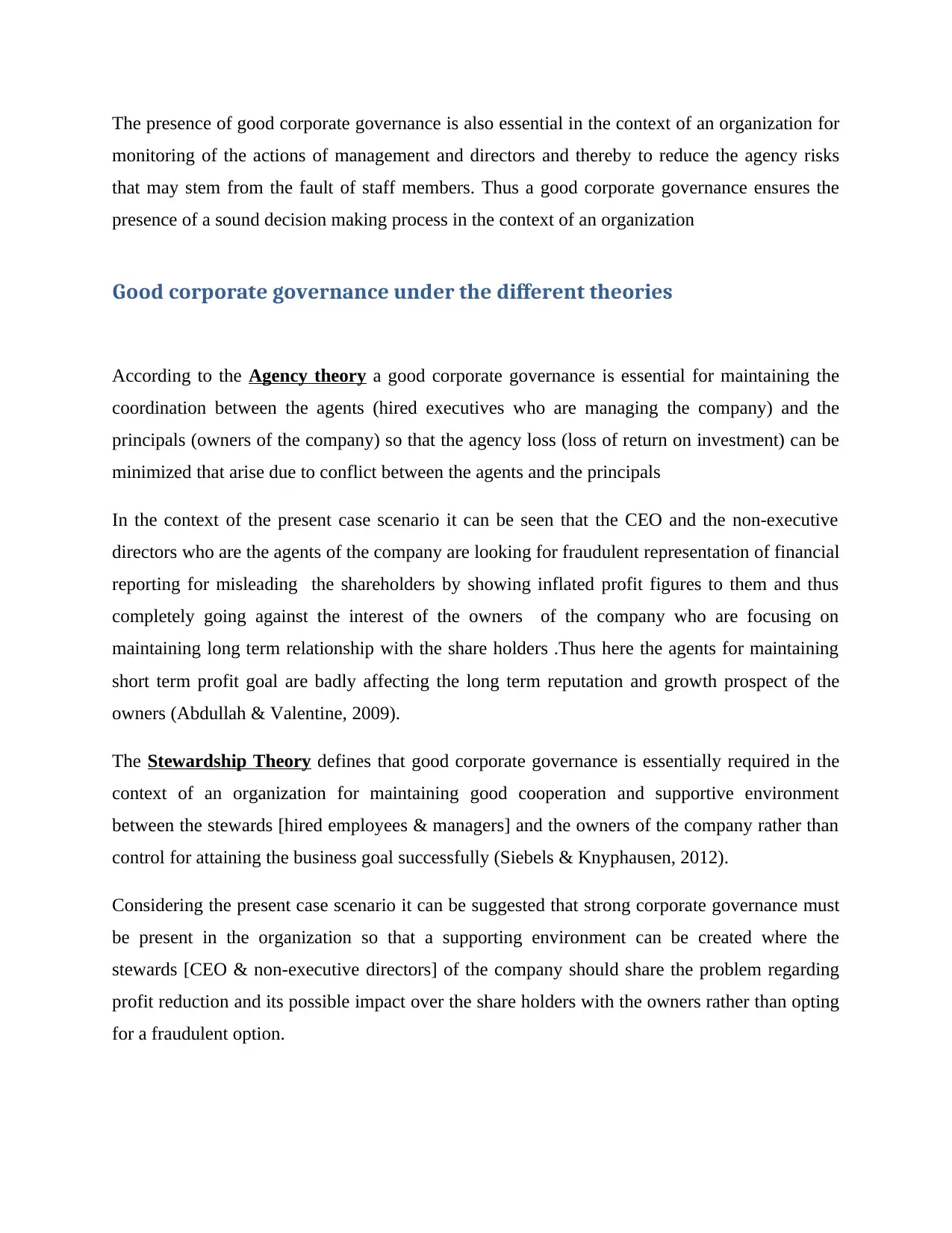
The presence of good corporate governance is also essential in the context of an organization for
monitoring of the actions of management and directors and thereby to reduce the agency risks
that may stem from the fault of staff members. Thus a good corporate governance ensures the
presence of a sound decision making process in the context of an organization
Good corporate governance under the different theories
According to the Agency theory a good corporate governance is essential for maintaining the
coordination between the agents (hired executives who are managing the company) and the
principals (owners of the company) so that the agency loss (loss of return on investment) can be
minimized that arise due to conflict between the agents and the principals
In the context of the present case scenario it can be seen that the CEO and the non-executive
directors who are the agents of the company are looking for fraudulent representation of financial
reporting for misleading the shareholders by showing inflated profit figures to them and thus
completely going against the interest of the owners of the company who are focusing on
maintaining long term relationship with the share holders .Thus here the agents for maintaining
short term profit goal are badly affecting the long term reputation and growth prospect of the
owners (Abdullah & Valentine, 2009).
The Stewardship Theory defines that good corporate governance is essentially required in the
context of an organization for maintaining good cooperation and supportive environment
between the stewards [hired employees & managers] and the owners of the company rather than
control for attaining the business goal successfully (Siebels & Knyphausen, 2012).
Considering the present case scenario it can be suggested that strong corporate governance must
be present in the organization so that a supporting environment can be created where the
stewards [CEO & non-executive directors] of the company should share the problem regarding
profit reduction and its possible impact over the share holders with the owners rather than opting
for a fraudulent option.
monitoring of the actions of management and directors and thereby to reduce the agency risks
that may stem from the fault of staff members. Thus a good corporate governance ensures the
presence of a sound decision making process in the context of an organization
Good corporate governance under the different theories
According to the Agency theory a good corporate governance is essential for maintaining the
coordination between the agents (hired executives who are managing the company) and the
principals (owners of the company) so that the agency loss (loss of return on investment) can be
minimized that arise due to conflict between the agents and the principals
In the context of the present case scenario it can be seen that the CEO and the non-executive
directors who are the agents of the company are looking for fraudulent representation of financial
reporting for misleading the shareholders by showing inflated profit figures to them and thus
completely going against the interest of the owners of the company who are focusing on
maintaining long term relationship with the share holders .Thus here the agents for maintaining
short term profit goal are badly affecting the long term reputation and growth prospect of the
owners (Abdullah & Valentine, 2009).
The Stewardship Theory defines that good corporate governance is essentially required in the
context of an organization for maintaining good cooperation and supportive environment
between the stewards [hired employees & managers] and the owners of the company rather than
control for attaining the business goal successfully (Siebels & Knyphausen, 2012).
Considering the present case scenario it can be suggested that strong corporate governance must
be present in the organization so that a supporting environment can be created where the
stewards [CEO & non-executive directors] of the company should share the problem regarding
profit reduction and its possible impact over the share holders with the owners rather than opting
for a fraudulent option.
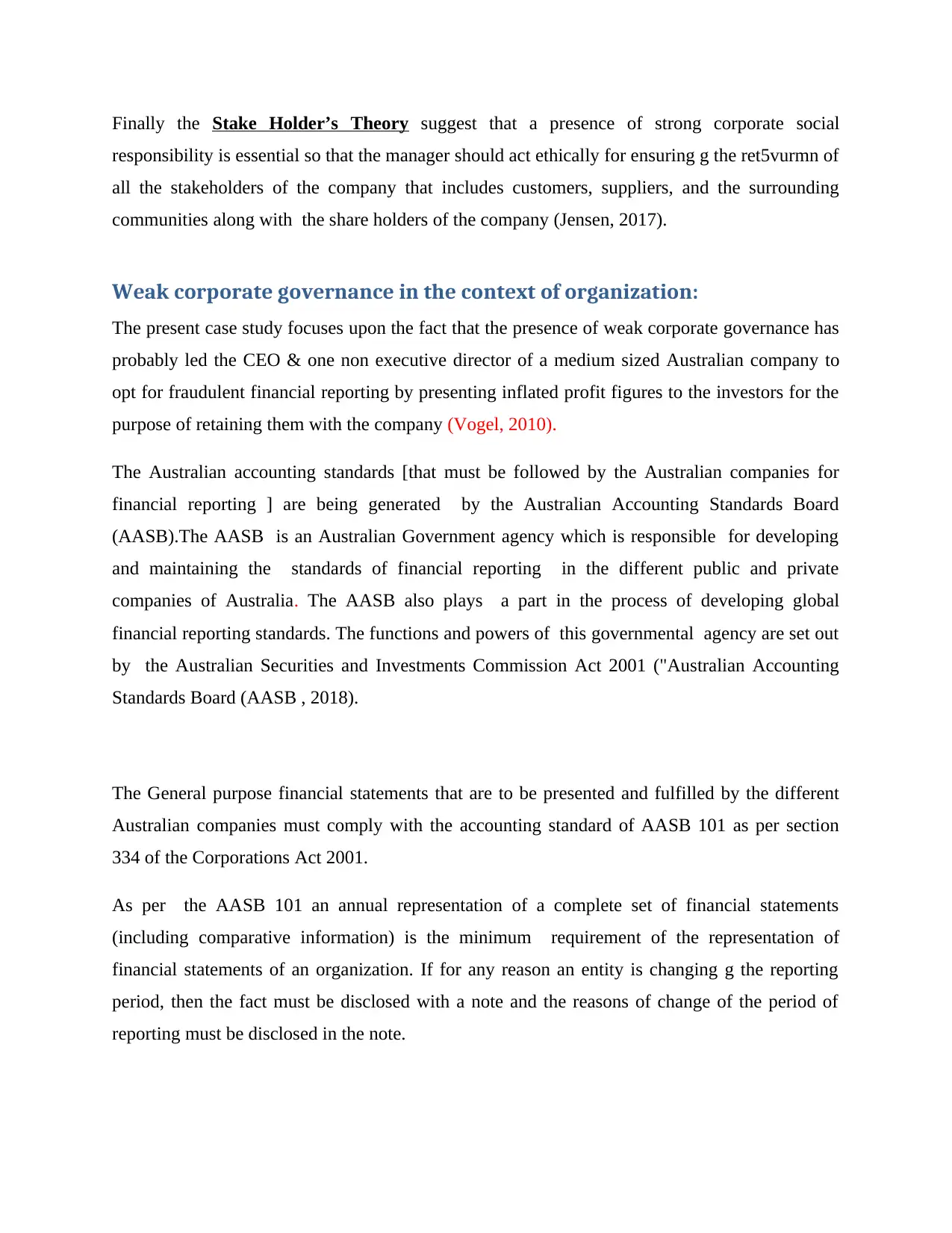
Finally the Stake Holder’s Theory suggest that a presence of strong corporate social
responsibility is essential so that the manager should act ethically for ensuring g the ret5vurmn of
all the stakeholders of the company that includes customers, suppliers, and the surrounding
communities along with the share holders of the company (Jensen, 2017).
Weak corporate governance in the context of organization:
The present case study focuses upon the fact that the presence of weak corporate governance has
probably led the CEO & one non executive director of a medium sized Australian company to
opt for fraudulent financial reporting by presenting inflated profit figures to the investors for the
purpose of retaining them with the company (Vogel, 2010).
The Australian accounting standards [that must be followed by the Australian companies for
financial reporting ] are being generated by the Australian Accounting Standards Board
(AASB).The AASB is an Australian Government agency which is responsible for developing
and maintaining the standards of financial reporting in the different public and private
companies of Australia. The AASB also plays a part in the process of developing global
financial reporting standards. The functions and powers of this governmental agency are set out
by the Australian Securities and Investments Commission Act 2001 ("Australian Accounting
Standards Board (AASB , 2018).
The General purpose financial statements that are to be presented and fulfilled by the different
Australian companies must comply with the accounting standard of AASB 101 as per section
334 of the Corporations Act 2001.
As per the AASB 101 an annual representation of a complete set of financial statements
(including comparative information) is the minimum requirement of the representation of
financial statements of an organization. If for any reason an entity is changing g the reporting
period, then the fact must be disclosed with a note and the reasons of change of the period of
reporting must be disclosed in the note.
responsibility is essential so that the manager should act ethically for ensuring g the ret5vurmn of
all the stakeholders of the company that includes customers, suppliers, and the surrounding
communities along with the share holders of the company (Jensen, 2017).
Weak corporate governance in the context of organization:
The present case study focuses upon the fact that the presence of weak corporate governance has
probably led the CEO & one non executive director of a medium sized Australian company to
opt for fraudulent financial reporting by presenting inflated profit figures to the investors for the
purpose of retaining them with the company (Vogel, 2010).
The Australian accounting standards [that must be followed by the Australian companies for
financial reporting ] are being generated by the Australian Accounting Standards Board
(AASB).The AASB is an Australian Government agency which is responsible for developing
and maintaining the standards of financial reporting in the different public and private
companies of Australia. The AASB also plays a part in the process of developing global
financial reporting standards. The functions and powers of this governmental agency are set out
by the Australian Securities and Investments Commission Act 2001 ("Australian Accounting
Standards Board (AASB , 2018).
The General purpose financial statements that are to be presented and fulfilled by the different
Australian companies must comply with the accounting standard of AASB 101 as per section
334 of the Corporations Act 2001.
As per the AASB 101 an annual representation of a complete set of financial statements
(including comparative information) is the minimum requirement of the representation of
financial statements of an organization. If for any reason an entity is changing g the reporting
period, then the fact must be disclosed with a note and the reasons of change of the period of
reporting must be disclosed in the note.
⊘ This is a preview!⊘
Do you want full access?
Subscribe today to unlock all pages.

Trusted by 1+ million students worldwide
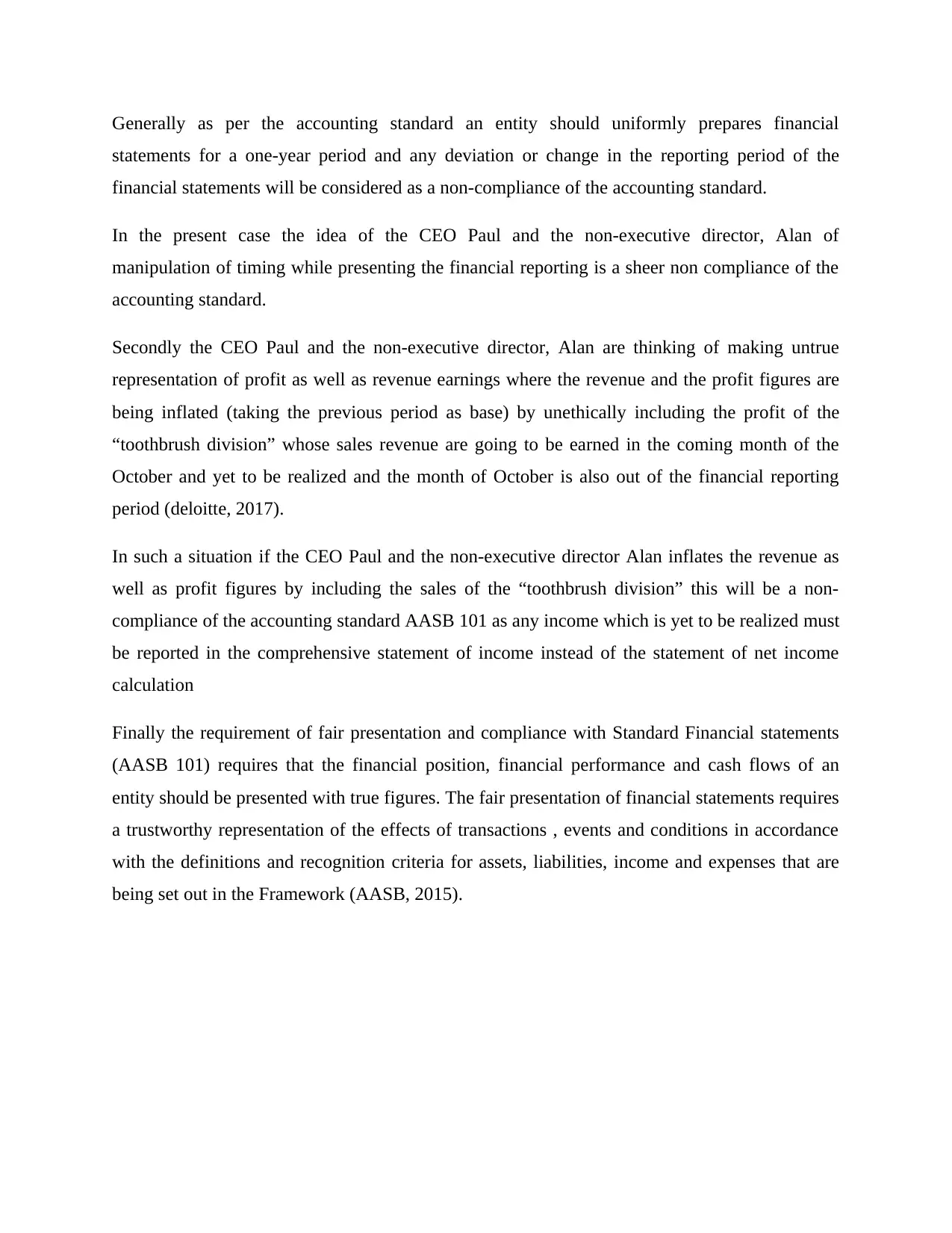
Generally as per the accounting standard an entity should uniformly prepares financial
statements for a one-year period and any deviation or change in the reporting period of the
financial statements will be considered as a non-compliance of the accounting standard.
In the present case the idea of the CEO Paul and the non-executive director, Alan of
manipulation of timing while presenting the financial reporting is a sheer non compliance of the
accounting standard.
Secondly the CEO Paul and the non-executive director, Alan are thinking of making untrue
representation of profit as well as revenue earnings where the revenue and the profit figures are
being inflated (taking the previous period as base) by unethically including the profit of the
“toothbrush division” whose sales revenue are going to be earned in the coming month of the
October and yet to be realized and the month of October is also out of the financial reporting
period (deloitte, 2017).
In such a situation if the CEO Paul and the non-executive director Alan inflates the revenue as
well as profit figures by including the sales of the “toothbrush division” this will be a non-
compliance of the accounting standard AASB 101 as any income which is yet to be realized must
be reported in the comprehensive statement of income instead of the statement of net income
calculation
Finally the requirement of fair presentation and compliance with Standard Financial statements
(AASB 101) requires that the financial position, financial performance and cash flows of an
entity should be presented with true figures. The fair presentation of financial statements requires
a trustworthy representation of the effects of transactions , events and conditions in accordance
with the definitions and recognition criteria for assets, liabilities, income and expenses that are
being set out in the Framework (AASB, 2015).
statements for a one-year period and any deviation or change in the reporting period of the
financial statements will be considered as a non-compliance of the accounting standard.
In the present case the idea of the CEO Paul and the non-executive director, Alan of
manipulation of timing while presenting the financial reporting is a sheer non compliance of the
accounting standard.
Secondly the CEO Paul and the non-executive director, Alan are thinking of making untrue
representation of profit as well as revenue earnings where the revenue and the profit figures are
being inflated (taking the previous period as base) by unethically including the profit of the
“toothbrush division” whose sales revenue are going to be earned in the coming month of the
October and yet to be realized and the month of October is also out of the financial reporting
period (deloitte, 2017).
In such a situation if the CEO Paul and the non-executive director Alan inflates the revenue as
well as profit figures by including the sales of the “toothbrush division” this will be a non-
compliance of the accounting standard AASB 101 as any income which is yet to be realized must
be reported in the comprehensive statement of income instead of the statement of net income
calculation
Finally the requirement of fair presentation and compliance with Standard Financial statements
(AASB 101) requires that the financial position, financial performance and cash flows of an
entity should be presented with true figures. The fair presentation of financial statements requires
a trustworthy representation of the effects of transactions , events and conditions in accordance
with the definitions and recognition criteria for assets, liabilities, income and expenses that are
being set out in the Framework (AASB, 2015).
Paraphrase This Document
Need a fresh take? Get an instant paraphrase of this document with our AI Paraphraser
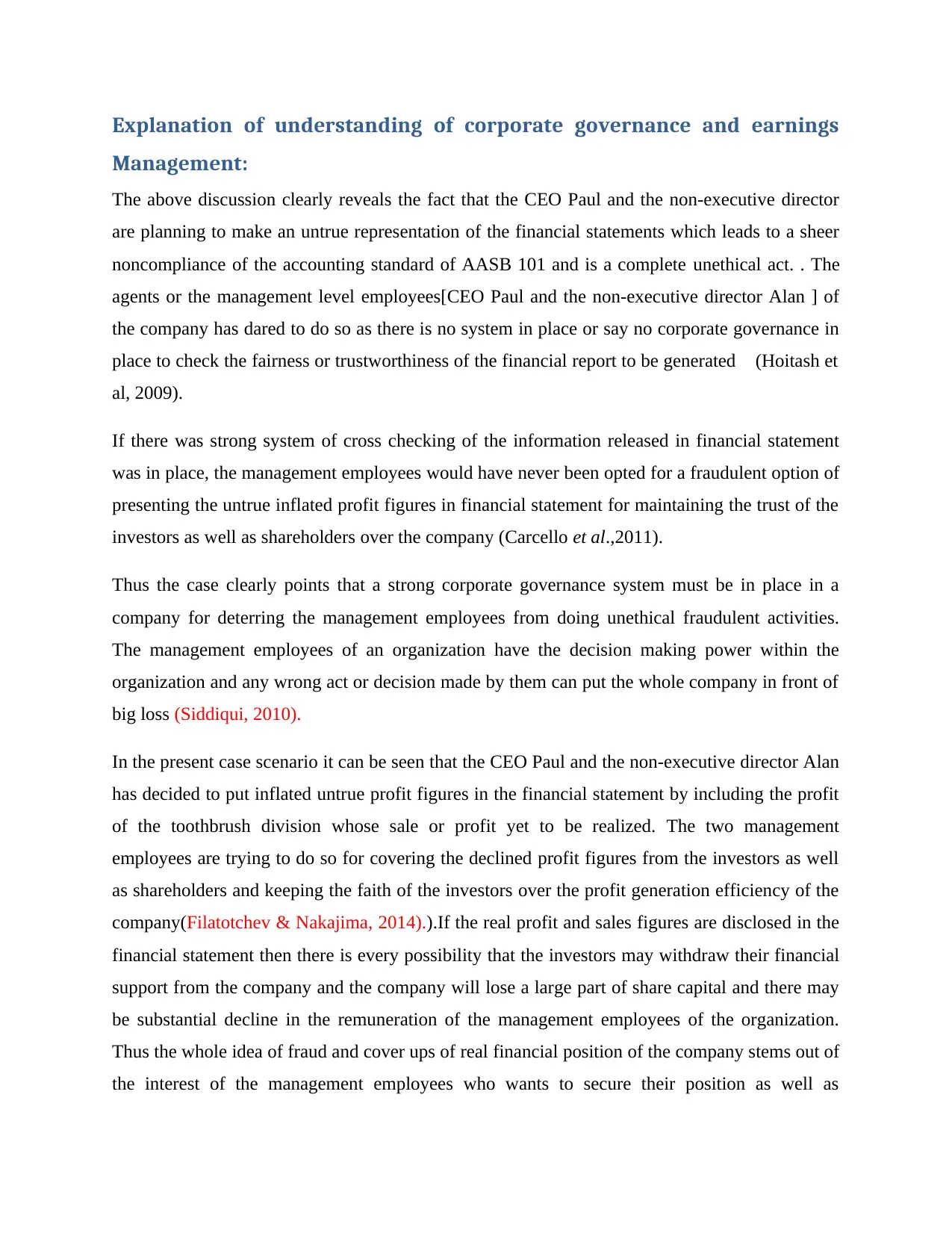
Explanation of understanding of corporate governance and earnings
Management:
The above discussion clearly reveals the fact that the CEO Paul and the non-executive director
are planning to make an untrue representation of the financial statements which leads to a sheer
noncompliance of the accounting standard of AASB 101 and is a complete unethical act. . The
agents or the management level employees[CEO Paul and the non-executive director Alan ] of
the company has dared to do so as there is no system in place or say no corporate governance in
place to check the fairness or trustworthiness of the financial report to be generated (Hoitash et
al, 2009).
If there was strong system of cross checking of the information released in financial statement
was in place, the management employees would have never been opted for a fraudulent option of
presenting the untrue inflated profit figures in financial statement for maintaining the trust of the
investors as well as shareholders over the company (Carcello et al.,2011).
Thus the case clearly points that a strong corporate governance system must be in place in a
company for deterring the management employees from doing unethical fraudulent activities.
The management employees of an organization have the decision making power within the
organization and any wrong act or decision made by them can put the whole company in front of
big loss (Siddiqui, 2010).
In the present case scenario it can be seen that the CEO Paul and the non-executive director Alan
has decided to put inflated untrue profit figures in the financial statement by including the profit
of the toothbrush division whose sale or profit yet to be realized. The two management
employees are trying to do so for covering the declined profit figures from the investors as well
as shareholders and keeping the faith of the investors over the profit generation efficiency of the
company(Filatotchev & Nakajima, 2014).).If the real profit and sales figures are disclosed in the
financial statement then there is every possibility that the investors may withdraw their financial
support from the company and the company will lose a large part of share capital and there may
be substantial decline in the remuneration of the management employees of the organization.
Thus the whole idea of fraud and cover ups of real financial position of the company stems out of
the interest of the management employees who wants to secure their position as well as
Management:
The above discussion clearly reveals the fact that the CEO Paul and the non-executive director
are planning to make an untrue representation of the financial statements which leads to a sheer
noncompliance of the accounting standard of AASB 101 and is a complete unethical act. . The
agents or the management level employees[CEO Paul and the non-executive director Alan ] of
the company has dared to do so as there is no system in place or say no corporate governance in
place to check the fairness or trustworthiness of the financial report to be generated (Hoitash et
al, 2009).
If there was strong system of cross checking of the information released in financial statement
was in place, the management employees would have never been opted for a fraudulent option of
presenting the untrue inflated profit figures in financial statement for maintaining the trust of the
investors as well as shareholders over the company (Carcello et al.,2011).
Thus the case clearly points that a strong corporate governance system must be in place in a
company for deterring the management employees from doing unethical fraudulent activities.
The management employees of an organization have the decision making power within the
organization and any wrong act or decision made by them can put the whole company in front of
big loss (Siddiqui, 2010).
In the present case scenario it can be seen that the CEO Paul and the non-executive director Alan
has decided to put inflated untrue profit figures in the financial statement by including the profit
of the toothbrush division whose sale or profit yet to be realized. The two management
employees are trying to do so for covering the declined profit figures from the investors as well
as shareholders and keeping the faith of the investors over the profit generation efficiency of the
company(Filatotchev & Nakajima, 2014).).If the real profit and sales figures are disclosed in the
financial statement then there is every possibility that the investors may withdraw their financial
support from the company and the company will lose a large part of share capital and there may
be substantial decline in the remuneration of the management employees of the organization.
Thus the whole idea of fraud and cover ups of real financial position of the company stems out of
the interest of the management employees who wants to secure their position as well as
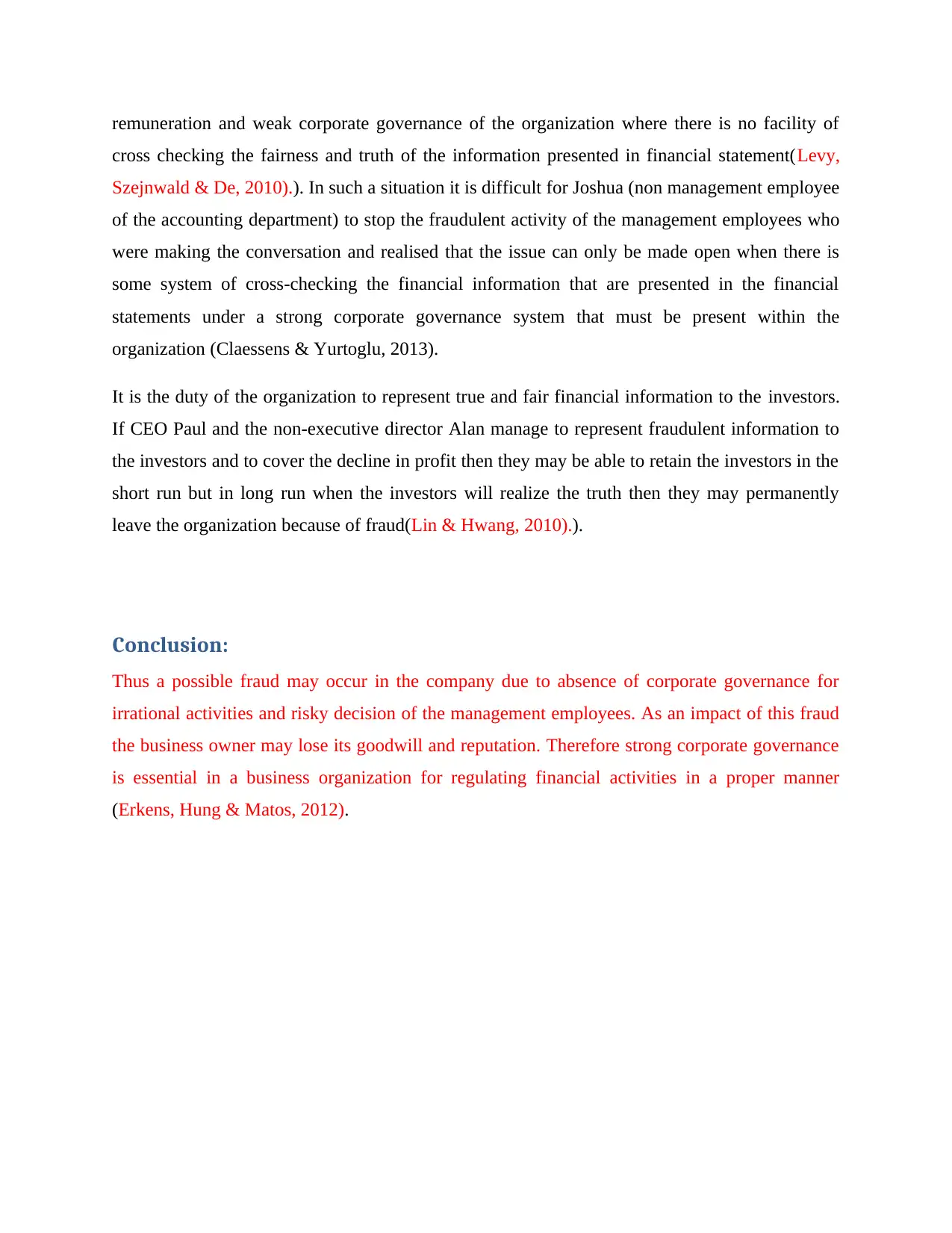
remuneration and weak corporate governance of the organization where there is no facility of
cross checking the fairness and truth of the information presented in financial statement(Levy,
Szejnwald & De, 2010).). In such a situation it is difficult for Joshua (non management employee
of the accounting department) to stop the fraudulent activity of the management employees who
were making the conversation and realised that the issue can only be made open when there is
some system of cross-checking the financial information that are presented in the financial
statements under a strong corporate governance system that must be present within the
organization (Claessens & Yurtoglu, 2013).
It is the duty of the organization to represent true and fair financial information to the investors.
If CEO Paul and the non-executive director Alan manage to represent fraudulent information to
the investors and to cover the decline in profit then they may be able to retain the investors in the
short run but in long run when the investors will realize the truth then they may permanently
leave the organization because of fraud(Lin & Hwang, 2010).).
Conclusion:
Thus a possible fraud may occur in the company due to absence of corporate governance for
irrational activities and risky decision of the management employees. As an impact of this fraud
the business owner may lose its goodwill and reputation. Therefore strong corporate governance
is essential in a business organization for regulating financial activities in a proper manner
(Erkens, Hung & Matos, 2012).
cross checking the fairness and truth of the information presented in financial statement(Levy,
Szejnwald & De, 2010).). In such a situation it is difficult for Joshua (non management employee
of the accounting department) to stop the fraudulent activity of the management employees who
were making the conversation and realised that the issue can only be made open when there is
some system of cross-checking the financial information that are presented in the financial
statements under a strong corporate governance system that must be present within the
organization (Claessens & Yurtoglu, 2013).
It is the duty of the organization to represent true and fair financial information to the investors.
If CEO Paul and the non-executive director Alan manage to represent fraudulent information to
the investors and to cover the decline in profit then they may be able to retain the investors in the
short run but in long run when the investors will realize the truth then they may permanently
leave the organization because of fraud(Lin & Hwang, 2010).).
Conclusion:
Thus a possible fraud may occur in the company due to absence of corporate governance for
irrational activities and risky decision of the management employees. As an impact of this fraud
the business owner may lose its goodwill and reputation. Therefore strong corporate governance
is essential in a business organization for regulating financial activities in a proper manner
(Erkens, Hung & Matos, 2012).
⊘ This is a preview!⊘
Do you want full access?
Subscribe today to unlock all pages.

Trusted by 1+ million students worldwide
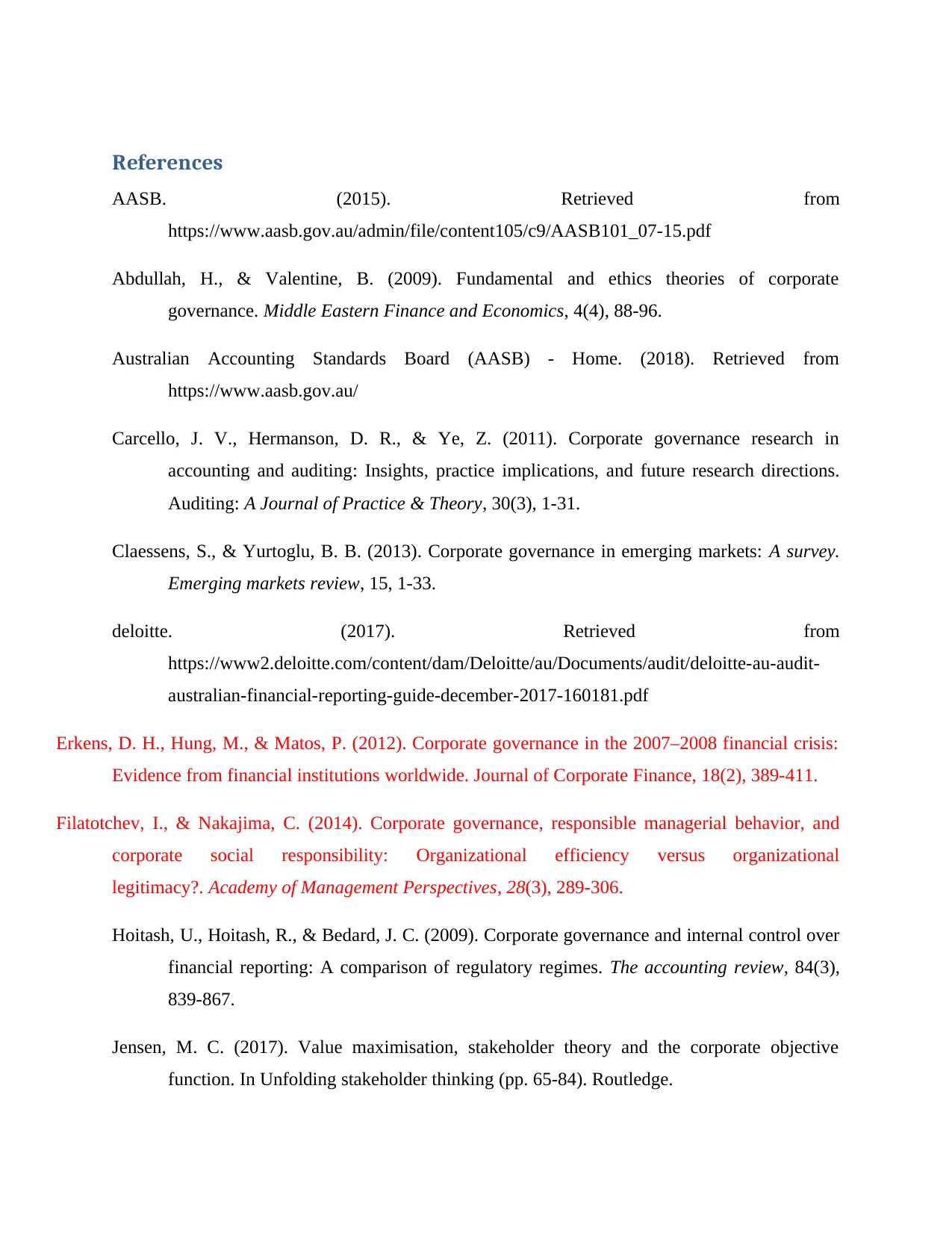
References
AASB. (2015). Retrieved from
https://www.aasb.gov.au/admin/file/content105/c9/AASB101_07-15.pdf
Abdullah, H., & Valentine, B. (2009). Fundamental and ethics theories of corporate
governance. Middle Eastern Finance and Economics, 4(4), 88-96.
Australian Accounting Standards Board (AASB) - Home. (2018). Retrieved from
https://www.aasb.gov.au/
Carcello, J. V., Hermanson, D. R., & Ye, Z. (2011). Corporate governance research in
accounting and auditing: Insights, practice implications, and future research directions.
Auditing: A Journal of Practice & Theory, 30(3), 1-31.
Claessens, S., & Yurtoglu, B. B. (2013). Corporate governance in emerging markets: A survey.
Emerging markets review, 15, 1-33.
deloitte. (2017). Retrieved from
https://www2.deloitte.com/content/dam/Deloitte/au/Documents/audit/deloitte-au-audit-
australian-financial-reporting-guide-december-2017-160181.pdf
Erkens, D. H., Hung, M., & Matos, P. (2012). Corporate governance in the 2007–2008 financial crisis:
Evidence from financial institutions worldwide. Journal of Corporate Finance, 18(2), 389-411.
Filatotchev, I., & Nakajima, C. (2014). Corporate governance, responsible managerial behavior, and
corporate social responsibility: Organizational efficiency versus organizational
legitimacy?. Academy of Management Perspectives, 28(3), 289-306.
Hoitash, U., Hoitash, R., & Bedard, J. C. (2009). Corporate governance and internal control over
financial reporting: A comparison of regulatory regimes. The accounting review, 84(3),
839-867.
Jensen, M. C. (2017). Value maximisation, stakeholder theory and the corporate objective
function. In Unfolding stakeholder thinking (pp. 65-84). Routledge.
AASB. (2015). Retrieved from
https://www.aasb.gov.au/admin/file/content105/c9/AASB101_07-15.pdf
Abdullah, H., & Valentine, B. (2009). Fundamental and ethics theories of corporate
governance. Middle Eastern Finance and Economics, 4(4), 88-96.
Australian Accounting Standards Board (AASB) - Home. (2018). Retrieved from
https://www.aasb.gov.au/
Carcello, J. V., Hermanson, D. R., & Ye, Z. (2011). Corporate governance research in
accounting and auditing: Insights, practice implications, and future research directions.
Auditing: A Journal of Practice & Theory, 30(3), 1-31.
Claessens, S., & Yurtoglu, B. B. (2013). Corporate governance in emerging markets: A survey.
Emerging markets review, 15, 1-33.
deloitte. (2017). Retrieved from
https://www2.deloitte.com/content/dam/Deloitte/au/Documents/audit/deloitte-au-audit-
australian-financial-reporting-guide-december-2017-160181.pdf
Erkens, D. H., Hung, M., & Matos, P. (2012). Corporate governance in the 2007–2008 financial crisis:
Evidence from financial institutions worldwide. Journal of Corporate Finance, 18(2), 389-411.
Filatotchev, I., & Nakajima, C. (2014). Corporate governance, responsible managerial behavior, and
corporate social responsibility: Organizational efficiency versus organizational
legitimacy?. Academy of Management Perspectives, 28(3), 289-306.
Hoitash, U., Hoitash, R., & Bedard, J. C. (2009). Corporate governance and internal control over
financial reporting: A comparison of regulatory regimes. The accounting review, 84(3),
839-867.
Jensen, M. C. (2017). Value maximisation, stakeholder theory and the corporate objective
function. In Unfolding stakeholder thinking (pp. 65-84). Routledge.
Paraphrase This Document
Need a fresh take? Get an instant paraphrase of this document with our AI Paraphraser
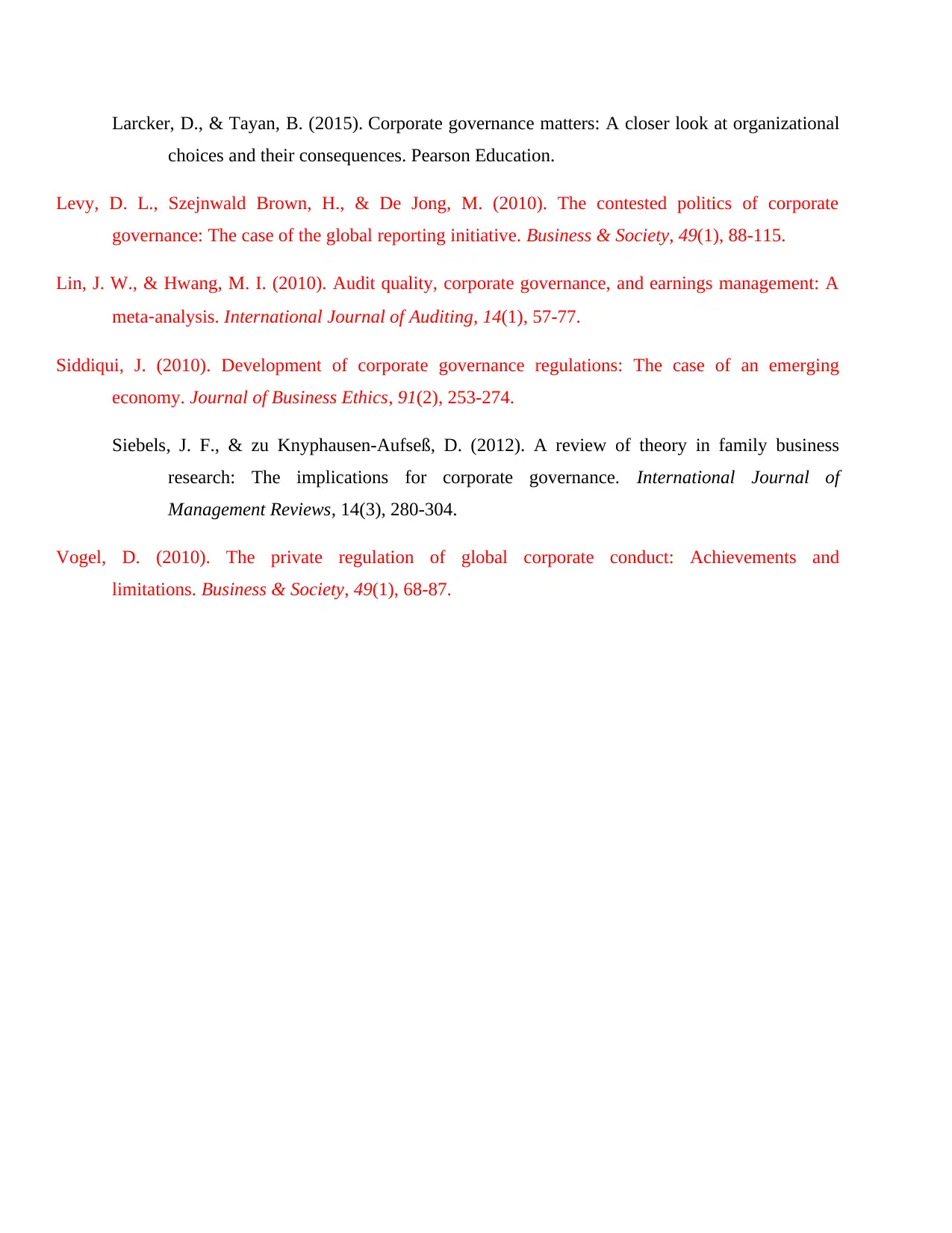
Larcker, D., & Tayan, B. (2015). Corporate governance matters: A closer look at organizational
choices and their consequences. Pearson Education.
Levy, D. L., Szejnwald Brown, H., & De Jong, M. (2010). The contested politics of corporate
governance: The case of the global reporting initiative. Business & Society, 49(1), 88-115.
Lin, J. W., & Hwang, M. I. (2010). Audit quality, corporate governance, and earnings management: A
meta‐analysis. International Journal of Auditing, 14(1), 57-77.
Siddiqui, J. (2010). Development of corporate governance regulations: The case of an emerging
economy. Journal of Business Ethics, 91(2), 253-274.
Siebels, J. F., & zu Knyphausen‐Aufseß, D. (2012). A review of theory in family business
research: The implications for corporate governance. International Journal of
Management Reviews, 14(3), 280-304.
Vogel, D. (2010). The private regulation of global corporate conduct: Achievements and
limitations. Business & Society, 49(1), 68-87.
choices and their consequences. Pearson Education.
Levy, D. L., Szejnwald Brown, H., & De Jong, M. (2010). The contested politics of corporate
governance: The case of the global reporting initiative. Business & Society, 49(1), 88-115.
Lin, J. W., & Hwang, M. I. (2010). Audit quality, corporate governance, and earnings management: A
meta‐analysis. International Journal of Auditing, 14(1), 57-77.
Siddiqui, J. (2010). Development of corporate governance regulations: The case of an emerging
economy. Journal of Business Ethics, 91(2), 253-274.
Siebels, J. F., & zu Knyphausen‐Aufseß, D. (2012). A review of theory in family business
research: The implications for corporate governance. International Journal of
Management Reviews, 14(3), 280-304.
Vogel, D. (2010). The private regulation of global corporate conduct: Achievements and
limitations. Business & Society, 49(1), 68-87.
1 out of 11
Related Documents
Your All-in-One AI-Powered Toolkit for Academic Success.
+13062052269
info@desklib.com
Available 24*7 on WhatsApp / Email
![[object Object]](/_next/static/media/star-bottom.7253800d.svg)
Unlock your academic potential
Copyright © 2020–2025 A2Z Services. All Rights Reserved. Developed and managed by ZUCOL.





